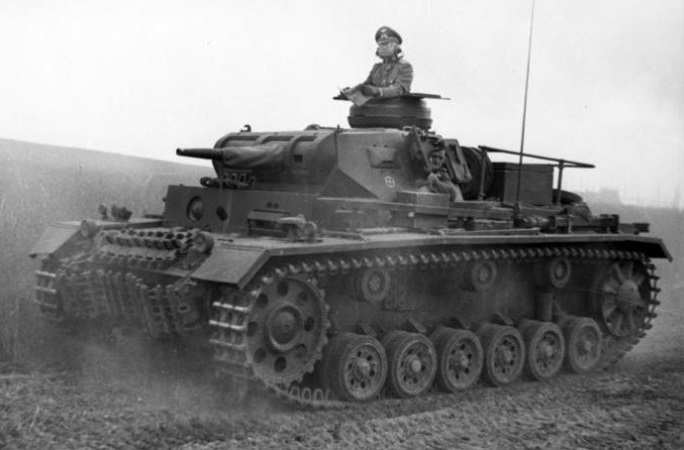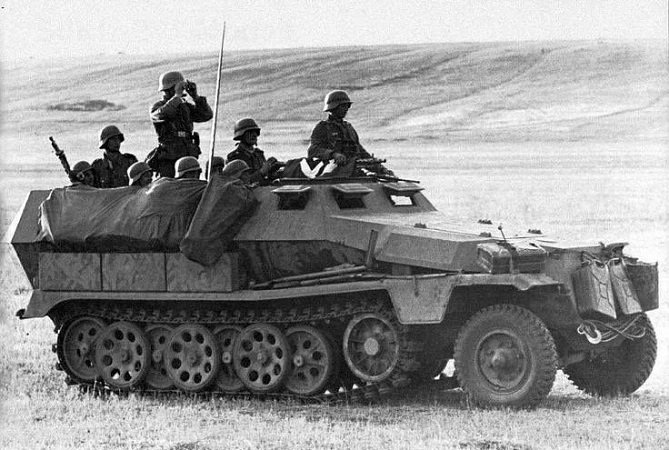The German word for armor is
Panzer, and this was the designation of its armored
branch of service, the Panzertruppen (armored
troops), and of its armored formations, e.g. 1. Panzer-Division. Lower-echelon armored formations were the
Panzer-Brigade, the Panzer-Regiment and the
Panzer-Ableilung (battalion). Motorized infantry
elements of the panzer divisions were the
Schützen-Brigade, the
Schützen-Regiment and the
Schützen-Bataillon (rifle brigade, regiment, battalion),
and the Kradschützen-Batallion
(motorcycle rifle battalion). The Aufklärungs-Abteilung
(retitled Panzer-Aufklärungs-Abteilung
in early 1940)
was the divisional reconnaissance battalion and the
Panzer-Abwehr-Abeiling
(retitled
Panzerjäger-Abteilung in early
1940) was the divisional antitank battalion. Other
divisional units, such as artillery regiments and signal
battalions, had
motorisiert,
(motorized) appended, e.g. 72. Artillerie-Regiment (motorisiert)—often
abbreviated to (mot).
The light mechanized
divisions were called simply light divisions (motorized),
e.g. 3. Liechte-Division (motorisiert);
their infantry sub-units bore cavalry identities, e.g. 8.
Kavallerie-Schützen-Regiment. In line
with the cavalry tradition, battalions of these
regiments were called Abteilungen. Units of other
branches of service were titled as in the panzer divisions.
General
control of armored and motorized forces was exercised by
the Panzerwaffe (lit. Armored Weapon, usually
translated as Armored Command). The panzer, light mechanized
and motorized infantry divisions were made
up of units from various branches of
service—infantry, artillery, combat engineer, signal, etc.—in
addition to the Panzertruppen, and it was the
responsibility of the Panzerwaffe to supervise their
organization and training in accordance with a common
armored warfare doctrine.
The “L” designation applied to 37mm
and larger tank guns indicated barrel length; the longer the
barrel, the higher the muzzle velocity of the gun and the
greater its ability to penetrate armor.
● ● ●
The German Army's first three panzer
divisions were activated in 1935 and at the beginning of the
war (September 1939) there were five of them in the
order of battle, along with four light mechanized
divisions and two provisional panzer formations whose units
later were used to form another division.
The five panzer divisions were
organized with two panzer regiments (four battalions) and a
variable number of motorcycle and motorized infantry
battalions. The panzer regiments were under a brigade
headquarters, as were the motorized infantry regiments of the 1st,
2nd and 3rd Panzer Divisions. The other two had no
infantry brigade headquarters. Their motorized artillery regiments had
two battalions with 24 x 105mm howitzers in total. All five
divisions had a motorized reconnaissance
battalion, a motorized antitank battalion, and a motorized
engineer battalion. In this form they went to war,
spearheading a rapid victory over the gallant but outclassed
Polish Army.
The light mechanized divisions had
been conceived as successors to the horse cavalry divisions
of bygone days. They
were similar to the panzer divisions but had no panzer or
motorized infantry brigade headquarters and only one light
tank battalion. Two of them had a motorized reconnaissance
regiment with armored car and motorcycle infantry
battalions. The other two had separate motorized
reconnaissance and motorcycle infantry battalions. Prewar
maneuvers had disclosed that the light mechanized divisions
lacked sufficient punch and it was decided to convert them
to panzer divisions. The outbreak of war intervened,
however, and their conversion had to be postponed.
The basic armored unit of the panzer
division was the Panzer-Abteilung (battalion). In
1939 it had three companies, two of them with
7 x Panzer I (twin machine guns) and 16 x Panzer II (20mm
gun). The third company had 7 x Panzer II, 3 x Panzer III
(37mm L/45 gun) and 6 x Panzer IV (75mm L/24 gun). Counting
those in the signal platoon and reserve tank detachment, the
battalion had 19 x Panzer I, 36 x Panzer II, 5 x Panzer III
and 6 x Panzer IV. The Panzer I had originally been intended only for training;
it was pressed into front-line service to cover the shortage of
other tanks—the Panzer III in particular. As for the four
battalions allotted to the light divisions, two had
Panzer Is and Panzer IIs only, two had ex-Czech Panzer
35(t)s and Panzer 38(t)s, both armed with a 37mm L/48 gun,
and one had Panzer IVs. The Czech tanks were acceptable
substitutes for the missing Panzer III: well designed and
mechanically reliable. But unlike the Panzer III they lacked
sufficient “stretch” to incorporate improvements such as a
larger main gun, meaning that they would soon become
obsolete.

Early production Panzer
III armed with the 37mm gun (Bundesarchiv)
The operational pause that followed
the Polish campaign gave time for the panzer divisions to be
refitted, for the light mechanized divisions to be
converted, and for the provisional panzer formations to be
brought up to divisional strength. Thus by May 1940 the
German Army's order of battle included ten panzer divisions.
The original five and the new 10. Panzer-Division had the
authorized organization of two panzer regiments (four
battalions) and two motorized infantry regiments (four
battalions) under two brigade headquarters, and in addition
their artillery regiments had been reinforced with a
battalion of 12 x 150mm howitzers. Of the converted light
mechanized divisions, three (the new 6th, 7th, and 8th) had
a panzer regiment of three battalions, largely equipped with former Czech tanks, and the fourth
(the new 9th) had a panzer regiment of two
battalions, equipped with German tanks. All newer divisions except
the 8th still had significant numbers of the light Panzer I, armed
only with twin machine guns, and none had a 150mm howitzer battalion.
The basic unit of the panzer
division's motorized infantry brigade was the
Schützen-Regiment
(rifle regiment). Each regiment had two or three battalions,
which were supposed to be mounted in armored halftrack
troop carriers. But such vehicles were scarce and only the
1. Panzer-Division possessed them in significant
numbers: enough to equip all seven of the truck-borne
rifle companies in its motorized infantry regiment. At best,
the other nine divisions only received enough of them to
reequip a single rifle company apiece, otherwise relying on
unarmored trucks and motorcycles. The 3.
Schützen-Regiment (3. Panzer-Division) was typical, with trucks for four of its rifle
companies and motorcycles for the other two.
The motorized infantry brigades
themselves varied in composition. That of the
1. Panzer-Division had a rifle regiment of three battalions and a
separate motorcycle infantry battalion; that of the 4.
Panzer-Division had two rifle regiments, each with two
battalions; and that of the 7.
Panzer-Division had two
rifle regiments, each with two battalions, and a separate
motorcycle infantry battalion. The regiments themselves also
varied. In some, all rifle companies were truck borne; in
others two were truck borne and one was mounted on
motorcycles.

Russia, 1941: an
armored infantry squad aboard a SPW 251 armored halftrack
(World War Photos)
As regards firepower and general
combat effectiveness, the 7. Panzer-Division was fairly
representative of the panzer divisions as a whole. On 10 May 1940
its tank strength was as follows: 34 x Panzer I, 68 x Panzer II, 91 x Panzer
38(t) and 24 x Panzer IV
. On paper, therefore, the German
armored formations had no great advantage over those of the
French Army. Indeed, the French tanks in
service in 1940 were in some ways definitely superior to their German
equivalents. The SOMUA S35 medium tank with its thick,
well-sloped armor and high-velocity 47mm main gun was more
than a match for the Panzer III or the Czech tanks. The
heavy Char-B tank, though slow, was well armed with the same
47mm gun plus a 75mm howitzer, and its armor was practically
impervious to German tank and antitank guns. Contrary to
legend, during the 1940 campaign French armored units proved
themselves capable of holding their own against the panzers
in a stand-up fight.
In other respects, however, the
Germans possessed important advantages. Unlike the French
and British, who made a distinction between “infantry” and
“cavalry” tanks, the German armored forcers—the Panzerwaffe—had
evolved a tactical doctrine for the employment of tanks as
the core of a combat team including infantry, artillery,
combat engineers and, crucially, airpower. This doctrine was
reflected throughout the panzer division's organization: in its
lavish allotment of radios, in its
armored reconnaissance battalion
configured not just to seek out information but to fight for
it, and in its allocation of supporting weapons to subordinate
units.
The successful outcome of the 1940
campaign resoundingly validated German tactical doctrine and
a major expansion of the Panzerwaffe was set in
motion. By the time of the invasion of the USSR (22 June
1941) there were twenty panzer divisions in existence. In
most of them the panzer brigade headquarters had been
eliminated and the tank contingent was embodied in a single
panzer regiment with two or three battalions. The panzer
battalion had two light companies and one medium company;
counting tanks in the battalion headquarters, signal platoon
and reserve tank detachment, its authorized strength was 22
x Panzer II, 38 x Panzer III and 15 x Panzer IV.
This was the envisioned standard,
but in June 1941 six divisions
were still largely equipped with Czech tanks, substituting
for the scarce Panzer III, and three
still had significant numbers of Panzer I light tanks. Those
divisions with Panzer IIIs mostly had a mix of the 37mm and
50mm gun-armed models. The Panzer IV was also in short
supply and one platoon (four tanks) was provisionally
deleted from the medium company, leaving ten tanks.
Finally, many of the reserve tank detachments were
understrength.
The panzer divisions had two
motorized rifle regiments, each with two battalions. One
battalion in each regiment was supposed to be mounted in armored halftracks
instead of trucks, but these were in short supply and only
1. Panzer-Division
had enough for two battalions. The 10.
Panzer-Division had one battalion so
equipped and the rest had only one or two halftrack-mounted
companies—in a couple of cases none at all.
The losses incurred in the first phase of the Russian
campaign were severe—so much so that the panzer divisions earmarked for
the 1942 summer offensive in the southern USSR could only be
rebuilt at the expense of those stationed on other sectors
of the front. Thus the panzer divisions of Army Groups North
and Center had their tank platoons reduced from five to three
or four tanks, usually older models like the 37mm gun-armed
Panzer III or Czech tanks. They also had to give up a proportion of their
artillery, antitank guns and armored reconnaissance
vehicles. Even so, Army Group South's panzer divisions could
only be built up to an average 80-85% of their authorized
strength. The strain of war was beginning to tell on the
Panzerwaffe.
See Also
Panzer
Divisions 1941-43 and
Panzer Divisions 1944-45
● ● ●